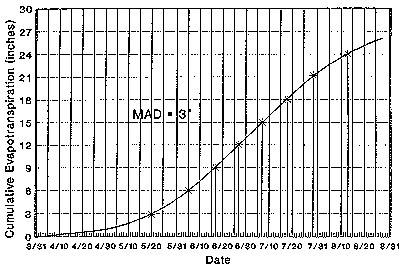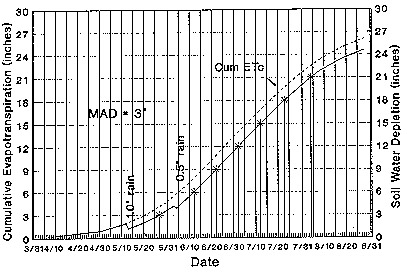Author:
Richard L. Snyder
Biometeorologist
University of California, Davis
Drought Tip 92-51 is a publication series developed as a cooperative effort by the following organizations:
California Department of Water Resources - Water Conservation Office
Department of Land, Air and Water Resources University of California
USDA Drought Response Office
USDA Soil Conservation Service If you have comments or suggestions, please email lawrweb@ucdavis.edu.
Last reviewed September 9, 2003
Drought Tip 92-51
Irrigation Scheduling of Surface-Irrigated Crops During a Drought
Knowing when to irrigate a crop and how much water to apply is crucial during a drought. Irrigation timing depends on the irrigation method, soil water intake characteristics, and the difference between the soil water content at field capacity (when the soil is full of water) and the measured or estimated (actual) soil water content.
The difference between field capacity and the actual soil water content is called the “soil water depletion.” When to irrigate and how much water to apply is determined by monitoring or estimating the soil water depletion and applying water when the depletion reaches a pre-selected level — called the management allowable depletion (MAD).
The most important consideration in setting the management allowable depletion level is optimizing application efficiency, but the MAD may have to be lowered to avoid yield-reducing water stress. Labor factors and other management considerations also affect the choice of MAD. An irrigation system evaluation is very important for efficient water management.
A crop should be irrigated when the actual soil water depletion is near the management allowable depletion. The gross amount of water to apply is figured according to the following equation:
- Applied Water = Actual Depletion/ Application Efficiency
Application efficiencies in the range of 75 to 85 percent for sloping furrow and 65 to 80 percent for border strip methods are attainable. Local farm advisors can provide information on how to determine application efficiency.
The set time in hours for an irrigation is calculated as follows:
- Set Time = Applied Water/ Application Rate
where applied water is in inches and the application rate is in inches per hour.
Estimating Soil Water Depletion
Water loss from a well-managed irrigated crop occurs mainly through crop evapotranspiration (ETc). Losses also occur during the irrigation process, but these can be minimized by reducing runoff and by infiltrating water uniformly over the field.
While irrigation is the main water source for California crops, rainfall, fog, and groundwater tables can also supply some crop water needs. Soil water depletion levels should therefore be updated daily by adding ETc and subtracting the water supplied by irrigation, rainfall, fog, or groundwater. The soil water depletion can never be less than zero, and the goal of each irrigation is to return the depletion to zero.
Crop Evapotranspiration (ETc)
Crop evapotranspiration (ETc) is calculated by multiplying reference evapotranspiration (ETo) by a crop coefficient (Kc)
- ETc = ETo x Kc
Average ETo by zones of similar evaporative demand are given in leaflet 92-54 in this Drought Tips series. Crop coefficients and ETc values by evaporative demand zone for specific crops grown in California are given in Drought Tips 92-44, 92-45, 92-46, 92-47, and 92-48.
Rainfall and Fog
Since rainfall contributes to crop water needs, soil water depletion estimates must be adjusted during rainy weather. Any rainfall that coats the plants or is stored in the root zone where the crop can use it for evapotranspiration is “effective rainfall.” Precipitation that causes the soil to exceed the soil water depletion before the rainfall will pass below the root zone and is not effective rainfall. Water that flows off the field as surface runoff is also not effective rainfall. Most rainfall that fills the soil up to the preceding soil water depletion is effective unless the rainfall is heavy, the field has a steep slope, or the soil has a slow intake rate.
During foggy periods, contributions to ETc by intercepted fog reduce soil water losses. When fog is intercepted, cumulative ETc over-estimates actual soil water depletion. A correction for fog interception can be made by noting the time fog dries off the crop and estimating the contribution as a fraction of daily ETc. See Drought Tip 92-40 for guidelines on how to correct for fog interception.
Irrigation Scheduling
A cumulative soil water depletion curve is useful for setting up an irrigation schedule. If rainfall, fog, and groundwater have not contributed to the field, cumulative ETC can be substituted for cumulative soil water depletion. Figure 1 shows a cumulative ETc curve for corn grown in the San Joaquin Valley. Using a MAD of 3.0 inches, an irrigation would be needed whenever the actual soil water depletion is near 3.0 inches (Figure 1). The amount to apply can be determined using Equation 1. For example, if the application efficiency is 75 percent, the applied water is 4.0 inches (3.0 divided by 0.75).Figure 1. Cumulative evapotranspiration curve for seed corn planted on April 1 in the San Joaquin Valley. Using a mangement allowable depletion of 3.0 inches and assuming no sources of water other than irrigation, application dates are May 20, June 5, June 17, June 27, July 7, July 18, July 29, and August 13.

Rainfall and fog may supply some of the water used by ETc and delay the attaining of 3.0 inches of depletion. For example, Figure 2 shows the cumulative ETc and soil water depletion curves when 1.0 inches of effective rainfall occurs before the first irrigation and 0.5 inches of effective rainfall occurs between the first and second irrigations. An application is needed whenever the soil water depletion approaches 3.0 inches, so the first irrigation is delayed until the cumulative ETc reaches 4.0 inches. The second irrigation occurs when the soil water depletion reaches 6.0 inches, corresponding to a cumulative ETc of 7.5 inches. The remaining irrigations occur whenever 3.0 inches of soil water depletion is accumulated between applications. In this case, rainfall eliminated the need for one irrigation during the season.

Figure 2. Cumulative evapotranspiration curve between April 1, and July 1 for seed corn planted on April 1 in the San Joaquin Valley. Using a management allowable depletion of 3.0 inches, but with 1.0 inches of effective rainfall before the first irrigation and 0.05 inches of effective rainfall between the first and second irrigations, application dates are May 27, June 12, June 22, July 2, July 12, July 23, and August 4.
Deficit Irrigation
Some drought-tolerant crops can be deficit-irrigated — given reduced amounts of water — with little loss in yield or quality if stress is avoided during critical periods. Excess water is usually applied to a crop to compensate for non-uniformity in the irrigation application. When these excess amounts are reduced, a smaller percentage of the field is refilled to field capacity at each irrigation.
The parts of the field with deficit soil water content may exhibit water stress, lower ETc, and reduced yield, but in some crops, such as cotton, canning tomatoes, and sugar beets, moderate stress from deficit irrigation results in a more marketable product. Stress-sensitive crops, of course, should not be deficit-irrigated.
References
Bowers, W.O., R.L. Snyder, S.B. Southard, and B.J. Lanini. 1989. Water-holding characteristics of California soils. University of California Leaflet 21463.
Hanson, B. 1992. Furrow irrigation. University of California Drought Tip 92-23.
Faber, B. and R. L. Snyder. 1992.South coast valleys evapotranspiration and crop coefficients for field crops. University of California Drought Tip 92-48.
Schulbach, K. and R.L. Snyder. 1992. "Central coast valleys evapotranspiration and crop coefficients for field crops." University of California Drought Tip 92-45.
1992." Reference evapotranspiration (ETo) averages for California." University of California Drought Tip 92-54.
——————. 1992. "Fog contributions to plant water needs." University of California Drought Tip 92-40.
Snyder, R.L. and K. Bali. 1992. "North coast valleys evapotranspiration and crop coefficients for field crops." University of California Drought Tip 92-44.
________________. 1992. "Sacramento Valley evapotranspiration and crop coefficients for field crops." University of California Drought Tip 92-46.
_______________. 1992. "San Joaquin Valley evapotranspiration and crop coefficients for field crops." University of California Drought Tip 92-47.
